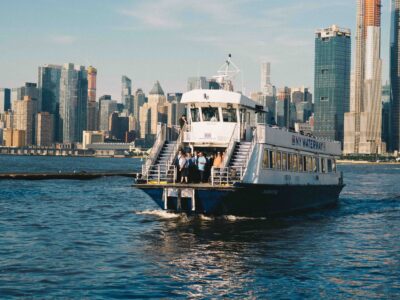(Bloomberg) —
In a rural California valley framed by redwood- and oak-covered hills, hawks circle above a meadow of native grasses where golf carts once trundled over acres of manicured, well-watered turf. Fairways are nothing but flowers now, and the remnant of a sand trap is a pop-up playground. Here and there, small stone obelisks inscribed with the words “San Geronimo Par 5” poke through a riot of yellow-and-white petals like signposts from a lost civilization.
When golf courses go out of business, large swathes of open space suddenly become available for redevelopment. In the United States, they have been transformed into suburban housing tracts, Amazon warehouses and even solar power plants. The San Geronimo Golf Course in Marin County, California, though, isn’t being developed so much as devolved to a state of nature to build resilience to climate change and revive endangered salmon while creating a new public park.
The former 18-hole course sits amid a mosaic of county, state and federal parks, including the 71,000-acre Point Reyes National Seashore. Opened nearly 60 years ago in anticipation of a planned— but never built— suburb, the financially troubled golf course went on the market in 2017.
The nonprofit Trust for Public Land purchased the 157-acre property, now called San Geronimo Commons, for $8.85 million and is in the midst a years-long project to uncover long-buried creeks and rewild fairways into wildlife habitat that will link the restored landscape to four surrounding nature preserves. Hiking and biking trails to be built through the Commons will connect communities in the valley.
“It’s a once-in-a-lifetime opportunity to recreate the historic floodplain and reconnect the creeks in a way that creates a far more climate-resilient ecosystem in this area,” says Christy Fischer, TPL’s Northern California coastal conservation director.
There are around 16,000 golf courses in the US, according the National Golf Foundation, and 130 closed in 2021. A 2017 study by landscape architect Kelly Cederberg of the University of Arizona determined that 1,500 golf courses shut down between 2006 and 2016. She found that of the 365 defunct courses examined in the study, 28 had been redesigned as open-space preserves or public parks.
Kristina Hill, an associate professor at the University of California at Berkeley’s Department of Landscape Architecture and Environmental Planning, says she expects that trend to continue as drought, sea-level rise, biodiversity loss and other climate impacts intensify.
“There’s going to be a lot of attention paid to golf courses along coastal areas and along rivers, and in areas that face elevated fire risks,” says Hill, who focuses on climate adaption. “Some golf courses will be under pressure to become a new land use that might be better adapted to flooding or fire conditions.”
In the years ahead, golfers may find a different state of play as courses adjust to a rapidly warming world. “It may be a change to more wetland environments in coastal golf courses as water levels rise,” says Hill. “We might see more vegetation that’s shrubs and trees. And that may change the layout and the way people play through a course.”
The road to the coastal forests and beaches of Marin County runs through San Geronimo, and I had driven past polo-shirted golfers teeing off countless times, a slice of suburbia amid the wild landscape and countercultural milieu of the valley’s hippie hamlets. (In the 1960s, the golf course’s next-door neighbors included a commune whose members lived in the hollowed-out trunks of giant primeval redwood trees.)
Over the past couple of years, the devolution of San Geronimo’s immaculate putting greens into unruly meadows has been like watching a nature documentary unfold in real time. But the ecological restoration of a golf course involves more than just letting nature take its course.
“It’s a big engineering challenge,” says Erica Williams, TPL’s San Geronimo Commons project manager, as she gives a tour of what was the front nine holes of the golf course and is now called San Geronimo Meadow. “There’s a lot of infrastructure under a golf course — pipes, culverts, drainage, electrical conduits.”
Those systems are being removed as the project proceeds, allowing creeks and streams to resume their natural path through the former golf course. We cross a bridge over San Geronimo Creek, which is flowing free for the first time in a century. The removal of a 100-year-old dam and other obstacles on the creek by local environmental group SPAWN is helping the survival of the last remaining Coho salmon population on the central coast of California by allowing the endangered fish to extend their spawning grounds into the former golf course as riparian habitat is restored. TPL’s acquisition of the golf course’s rights to 6.5 million gallons of water annually also is aiding the iconic salmon in their annual journey from the Pacific Ocean. Instead of irrigating 135 acres of turf in a drought-stricken county, the water is now dedicated to salmon-bearing creeks and streams.
Looking east from the bridge, a few artificial hills and hollows of the golf course remain visible through the grasses, weeds and wildflowers that have supplanted the turf. Others have been removed to allow the creek to flow through the reestablished floodplain during heavy rains. Trees are being planted along the creek to provide the shade and leafy debris salmon need. Further down the meadow, invasive grasses have been removed and replaced with native species that ripple in the breeze.
“By bringing back the floodplain and restoring wetlands, we’re allowing the land to retain moisture and become more resilient to wildfire and other climate impacts,” says Williams. “Reconnecting the stream to the floodplain enhances wildlife corridors that allow animals to adapt and migrate.”
Not everyone signed on to that vision. Golf course proponents waged a years-long but ultimately unsuccessful legal and political battle to derail the rewilding project.
Williams says the restoration is currently in “those awkward teenage years,” when the golf course turf has died off and weeds have moved into areas where native grasses have yet to be planted.
To the north, on what was the back nine holes of the golf course, a tributary of San Geronimo Creek called Larsen Creek provides habitat for salmon and threatened steelhead trout. A long stretch of the creek, though, hasn’t seen daylight since the 1960s when it was diverted underground to supply the golf course’s irrigation ponds. In the years ahead, TPL will uncover the creek and allow it to meander through what is now called Larsen Meadow.
Wildlife has begun to recolonize the Commons. A gopher pops its head out of a hole and then quickly disappears as raptors soar overhead. Williams says bobcats have been spotted, and she recently received a report of a black bear wandering near the property.
The former golf course clubhouse and the surrounding 22 acres is being dedicated to community use. On the day I visited, the 200-car parking lot was the site of a drive-through food pantry. A community garden near the clubhouse may be expanded. A conservation easement has been granted that permanently protects the Commons from development.
TPL is also involved in the restoration of the former Rancho Cañada golf course in Monterey County, California, to a natural state to revive a floodplain along the Carmel River.
“Projects like these do more than just create habitat and connect people to nature,” says TPL’s Fischer. “These places create a sense of hope where people can see things getting better.”
To contact the author of this story:
Todd Woody in San Francisco at twoody4@bloomberg.net
© 2022 Bloomberg L.P.





